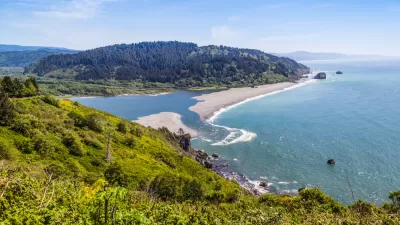Even in an epic drought, the long-awaited commencement of the $83 million San Clemente Dam removal project is welcomed as the obsolete dam posed a safety threat to downstream communities and provided very little water due to tremendous silt build-up.
San Clemente Dam, built in 1921 to provide water from the Carmel River for the Monterey Peninsula, is coming down, literally, "using a hoe ram, a kind of giant jackhammer chipping away at the concrete and reinforced steel structure," writes Jim Johnson for the Monterey Herald. At the same time, construction has begun on the new Carmel River channel with step pools to improve fish habitat [see photo 3 in photo gallery].

San Clemente Dam pre-destruction. Credit: San Clemente Dam Removal & Carmel River Reroute Project
After the dam flunked a seismic safety inspection in 1992, the owner, California American Water Company (Cal Am), with the encouragement of local, state, and federal legislators, settled on the "San Clemente Dam Removal & Carmel River Reroute Project." The removal of the 106-foot-high dam is the largest such project in the state's history and "could be a model for state water policy," writes Steve Rubenstein for the San Francisco Chronicle.
“Retrofitting it would have been like putting new tires on a car with a blown engine,” Monterey County Supervisor Dave Potter, in whose district the dam lies, said. “Dams are an antiquated technology. They were invented before Christ was born. They’re not good for the watershed, for the fish or for flood prevention.”
The "Background & History" section on the project website provides this explanation:
Strengthening the dam would resolve the public safety issues, but would not address other issues related to the dam such as impaired access for steelhead to 25 miles of upstream spawning and rearing habitat, disruption of sediment transport to the lower river and Carmel River beach, and ecological discontinuity of aquatic and riparian habitats.
"Cal Am project executive Rich Svindland called the beginning of demolition 'a huge milestone, there’s no question about that',” adds Johnson.
“We’ve reached the point of no return,” Svindland said. “I commend my fellow partners, the Coastal Conservancy and National Marine Fisheries, for getting to this point. We’re on the forefront of what will need to happen across the country, and we’ve proved it can be done.”
"Water for the county will come instead from existing underground wells," writes Rubenstein. "The huge pile of sediment — 2.5 million cubic yards of muck — will be allowed to remain in place." Water will continue to be supplied from the upstream Los Padres dam as well, though its future appears questionable.
The dam is expected to be removed entirely by the third week of August.
FULL STORY: San Clemente Dam teardown work begins; completion expected by end of month

Coming Soon to Ohio: The Largest Agrivoltaic Farm in the US
The ambitious 6,000-acre project will combine an 800-watt solar farm with crop and livestock production.

Pennsylvania Mall Conversion Bill Passes House
If passed, the bill would promote the adaptive reuse of defunct commercial buildings.

U.S. Supreme Court: California's Impact Fees May Violate Takings Clause
A California property owner took El Dorado County to state court after paying a traffic impact fee he felt was exorbitant. He lost in trial court, appellate court, and the California Supreme Court denied review. Then the U.S. Supreme Court acted.

Dallas Surburb Bans New Airbnbs
Plano’s city council banned all new permits for short-term rentals as concerns about their impacts on housing costs grow.

Divvy Introduces E-Bike Charging Docks
New, circular docks let e-bikes charge at stations, eliminating the need for frequent battery swaps.

How Freeway Projects Impact Climate Resilience
In addition to displacement and public health impacts, highway expansions can also make communities less resilient to flooding and other climate-related disasters.
City of Costa Mesa
Licking County
Barrett Planning Group LLC
HUD's Office of Policy Development and Research
Mpact Transit + Community
HUD's Office of Policy Development and Research
Tufts University, Department of Urban and Environmental Policy & Planning
City of Universal City TX
ULI Northwest Arkansas
Urban Design for Planners 1: Software Tools
This six-course series explores essential urban design concepts using open source software and equips planners with the tools they need to participate fully in the urban design process.
Planning for Universal Design
Learn the tools for implementing Universal Design in planning regulations.

























